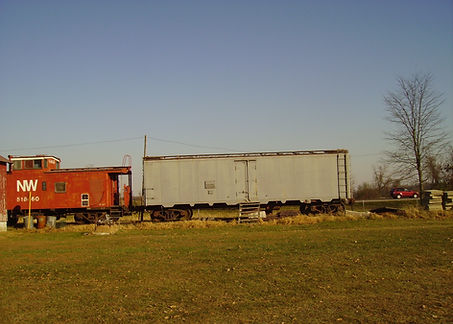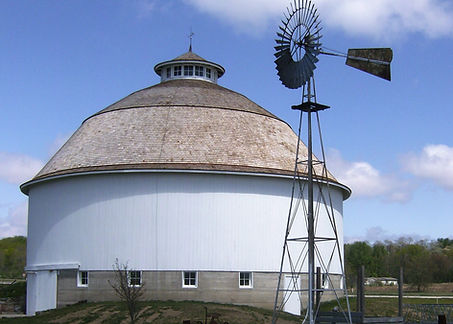
Fulton
County
History
Welcome to Loyal, Indiana
Living History Village
1900-1925
Fulton County's Living History Village is called Loyal, Indiana, for a little village that used to exist a few miles west of the museum. Originally named Germany, Indiana, the people changed the name to Loyal in 1918 when the U.S. was at war with Germany.
Loyal, Indiana, now depicts 1900-1925. This period of our history is known as the GOLDEN AGE OF AGRICULTURE because farmers made a profit and they could afford labor-saving equipment like hay elevators and riding cultivators and round barns! More round barns were built in Indiana than any other state. Round barns were an experimental structure touted by the Agricultural colleges as the most economical and best barn ever designed. It saved the farmer labor by having the animals all face the center for feeding.
The period is also called the GOLDEN AGE OF INDIANA LITERATURE because of so many great writers, such as James Whitcomb Riley, George Ade, Booth Tarkington, Gene Stratton Porter, etc.
The first quarter of the 20th century was a time of unprecedented change: from horse power to cars and aeroplanes, from isolation to World War I's global involvement. Cars and tractors were replacing horses -- blacksmiths were converting their shops into garages. The industrial revolution had reached the home and the farm, and everything was changing, including clothing styles, cooking utensils, labor-saving gadgets such as vacuum cleaners and apple peelers.
Did your parents or grandparents live during this time frame? If so, there is no better way to memorialize them than by a donation to this Living History Village. Your donation will preserve this era and help the school children of today and tomorrow see how your loved ones lived.
Leedy - Partridge - Paxton Round Barn
Leedy - Partridge - Paxton Round BarnThis round barn was built in 1924 by Bert Leedy. He had a regular rectangular barn that was struck by lightning in Oct. and burned to the ground. So he needed a new barn fast because he had livestock and cows to milk. His brother Ezra had built a round barn a few years before and must have told him it was a good thing. Round barns were advertised as faster, easier and cheaper to build. Forty neighbors came to help mix and pour the concrete floor and side walls. Then C.V. Kindig Construction Company built the wooden part of the barn, with only 2 to 4 men working at a time. It was done by
Christmas. Kindigs built several of Fulton County's 17 round barns.
Harold Partridge owned the round barn 1972-75. He died in the round barn after a heart attack while working on a lawn mower motor in the hayloft at the entrance at the top of the ramp.
The next owner was Larry Paxton. A tornado took the roof off this barn Sept. 1, 1989. Paxton donated it to the Fulton County Historical Society because Fulton County is the Round Barn Capital of the World and had only 9 round barns left.
The barn was moved and restored in 1990-91, with most of the work done by Fred Carr. FCHS got a loan of $40,000 from Historic Landmarks Foundation of Indiana. But it took $65,000 to move and reconstruct the barn. The barn was paid for with donations from many people. Now it is a museum with farm equipment and tools.
It is open year around Monday - Saturday from 9 to 5.



1876 Rochester Depot
Fulton County did not have a railroad until after the Civil War. The Indianapolis Peru & Chicago railroad was built in 1869, the same year the cross-continental rail was completed with a golden spike in Utah. So this depot is the oldest depot and on the first railroad in Fulton County. It was donated by Norfolk & Western to the Fulton County Historical Society in 1969 and was moved to Lakeview Park to become our first museum. Because it was our first museum and for several years, our only museum, the depot has a variety of items displayed in old cases. Now that it is part of the Living History Village, we are restoring it to the way it was when it
was a real depot. The 4-H Model Railroading Club will make a working model in the freight room to show the five railroads that existed in Fulton County in the early 1900s. One by one they have been torn out and now only one railroad still crosses Fulton County.
This depot and the log cabin were moved from Lakeview Park to form the nucleus of the Living History Village in 1992.
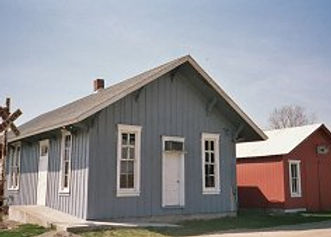
Dr. Shafer's Office
This house was built in 1934 for the manager's office at the Federal Fish Hatchery on East 9th Street, Rochester. The Fish Hatchery was closed and given to the city in 1965 and became Lakeview Park. In 1998 the city donated the house to FCHS and it was moved to the village for an old-time Doctors and Dentists office.
Displays include equipment donated by horse & buggy doctors, Woodlawn Hospital, dentists, nurses, and other medical professions. It is a memorial to those who gave so much to save lives and improve the health of this community. Barbara Shafer Leaverton and Betty Shafer Strauss, granddaughters of Dr. Winfield S. Shafer - the founder of Woodlawn Hospital in 1905, donated money to save the building so it is named Dr. Shafer's Offfice. Dr. W. S. Shafer's son, Dr. Howard
Shafer, operated Woodlawn Hospital 1916-1931. A grant of $1,000 from Northern Indiana Community Foundation was used to purchase materials to enclose a "Medical History Room" on the north side - this replaced a porch that was removed before the building was moved. Volunteers built the room and restored the building in 1998-99. FCHS is collecting names and memories of all medical persons in Fulton County to be recorded in a book to be placed in the Medical History Room, Write your memories and send to FCHS!
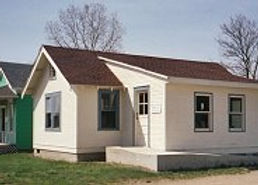
1920s General Store
Rural general stores were operated in regular houses, and the telephone
exchange was in the front room. This house was built in 1910 at 124 W. 9th Street, Rochester. The house was scheduled for demolition because the Rochester Telephone Company had purchased it to make a parking lot. RTC donated the house to FCHS. Fulton County Solid Waste District gave FCHS a grant of $8,000
to pay the mover so that it would not end up in the landfill. The house was restored by volunteers. RTC donated $2,000 for materials. In the front room is an old telephone switchboard, illustrating the fact that Germany had its own telephone exchange. In 1913 RTC bought out the Germany Exchange but continued to list its customers separately in the phone book, which is displayed by the switchboard.
During festivals candy is sold in the front room which has a candy case and old ice Coke machine. Florentine's Beauty Shoppe and a barber shop occupy the back room. Shelves and glass cases display items that would have been for sale in an old general store but they are for display only.
Friendly Swartz Cider Mill
This cider mill was moved from near Athens in 2000. A grant of $3,000 from the Northern Indiana Community Foundation helped to fund this. The huge iron cider press was last owned and operated by Friendly Swartz in 1962. The cider mill was built before 1900 and was owned by Frank and Lyda Moore from 1900 till Frank retired and then his son Carl operated it. Carl sold it to Friendly and Vera Swartz in 1958. Farmers would bring wagon loads of apples to be made into cider in the fall.
Horses and wagons and Model T trucks line up for a quarter of a mile waiting for their turn. They paid 3 cents a gallon to have their apples pressed into cider. Originally a horse powered the mill's line shaft. Later a gasoline engine did it and after REMC came in 1935, electricity provided the power.
Kewanna Jail
Small towns had little jails like this to keep drunks in overnight; then they transported them to the county jail the next day. This jail was in the Kewanna Town Hall 1912 to early 1960s. The Town Marshall was Elmer Hickle, who donated the stove. The jail was donated by the Kewanna Town Board. It was hauled here by Fred Oden and repaired by the blacksmiths. This building was donated by Howard Lease, Rochester.
Pioneer Woman's Log Cabin Museum
FCHS reconstructed this log cabin in Lakeview Park at Rochester as a 1976 Bicentennial project, using logs from two 1860 era cabins, donated by Miller Ault and Ted Merley. The Indiana blue limestone step is from the District 11 one-room school near Fulton. Vernie Bowen, father of Indiana Governor Otis Bowen, taught there in 1915-16. Today the cabin is furnished the way it would have been when lived in by pioneers, including a spinning wheel and a large loom. The cabin is part
of our annual Halloween party the last Friday of October.
William Polke House - 1832 Stagecoach Inn
William Polke House KitchenBuilt in 1832, this is the oldest house in Fulton County, and the first frame house built north of the Wabash River. It was known as the White House and served as an inn on the stagecoach line running north and south on the Michigan Road before the Civil War. William Polke was the first white settler in Fulton County, coming in 1830 to survey the Michigan Road. He built a log trading post on the Tippecanoe River and established a village there called Chippeway. He was the county's first postmaster, placing mail in a row of alphabetized boxes in his trading post. After he built this house in 1832, he had a land office there. This land office was probably just a desk where his daughter
Mary kept the records and wrote letters for him. We have copies of letters dated in 1833 at Chippeway, Indiana, and signed by Mary Polke.
Mary Polke was married in the parlor of this house in 1834. This wedding was attended by William Henry Harrison who became President in 1840. Harrison was a close friend of Polke and they both fought in the Battle of Tippecanoe. The house was donated by Airvac and was moved in May 1993.
Railroad Track, Caboose and Boxcar
The railroad track was donated from the bankrupt Erie Lackawanna Railroad between Akron and Rochester and from the Penn Central Railroad in Kewanna. Members of the Hoosier Valley Railroad Museum laid this 160 feet of track in 1995. They moved the 1971 Norfolk & Western caboose here after it was donated by Norfolk & Southern Corporation. A caboose was always attached to the back of the train so the men could keep a watch over the long line of moving cars and see if there was a "hot box" or fire in the wheel packing. The caboose was like a home away from home and had a hot plate to cook meals, a furnace, a restroom, and a kitchen sink. Today cabooses are no longer used on trains. The 1955 boxcar was commonly called an "ice reefer" as it had compartments for ice at both ends and a wheel went down to the rail to power fans inside. It was used by Merchants Dispatch Transport and was on an abandoned track at the old Pennsylvannia Railroad yard south of Indianapolis. McGill and Schlater transported the boxcar by taking off the train wheels, putting on truck tires and pulling it down the highway. The boxcar will be used as a museum with display cases inside. Wooden stairs and a landing will be built to make it accessible to school children. This will free up space in the old Rochester depot so that the freight room can be restored with a new floor. In the freight room the 4-H Model Railroad Club will make a railroad display showing the five railroads that existed in Fulton County.
Railcar and Parrot's Garage
A railcar was used by track repairmen to ride out and check the track and then fix it. If there was a weak place in the track, it could de-rail the train and cause the lose of life and property. This motorized rail car was built in the 1940s. It was restored by Clair Coahran, Macy, and friends. The garage was donated by Bill Willard's sister, Shirley, whom he always called "Parrot".

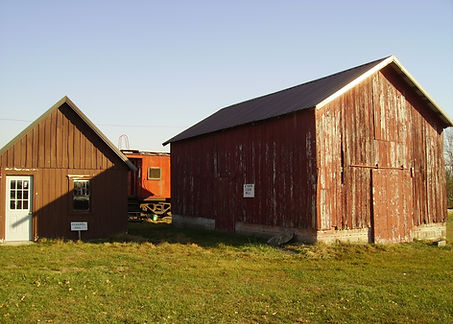
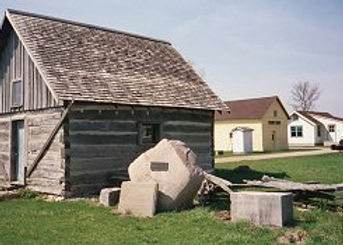
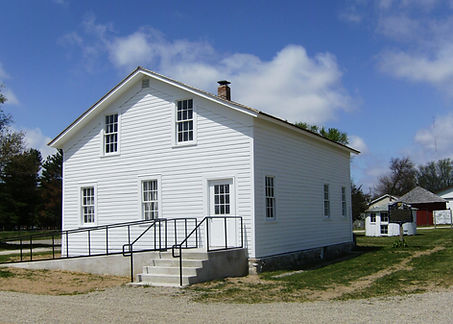
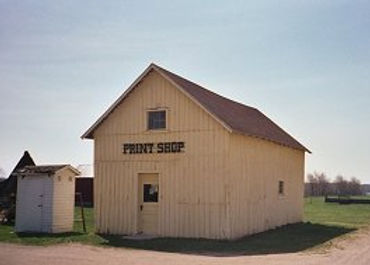
Wind Mill
Wind mills were important on the farm to pump water for the livestock as well as supply the household. This wind mill was manufactured during the 1920s or 30s and was used to pump water for livestock on the farm of Claude Masteller, south of Rochester.
Rochester Bridge Company
This little foot bridge is made from an iron bridge that used to be on a county road. Rochester Bridge Company made iron truss bridges from the 1870s to 1935 when the company went out of business during the Great Depression.
Round Chicken House
This "little round barn" is really a brooder house for raising baby chicks. We put all kinds of chicken equipment in it: nests, feeders, waterers, incubator, egg washer, artificial baby chicks and baby ducks. This chicken house was built about 1940 by Ernsberger Lumber, Mentone. It was donated by Forrest Pfeiffer, in memory of his wife Frances who was chairman of the Round Barn Festival for several years.
